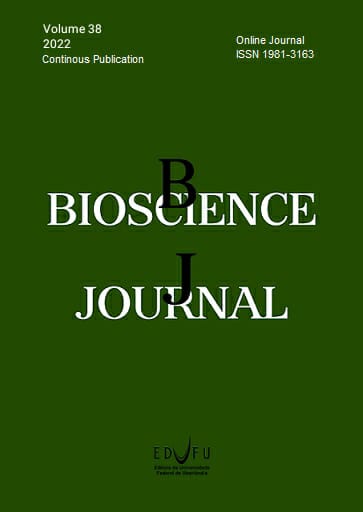Hematologic parameters of captive Bothrops atrox (Squamata: viperidae)
DOI:
https://doi.org/10.14393/BJ-v38n0a2022-62653Keywords:
Blood Count, Clinical Pathology, Leukogram, Reptile.Abstract
The breeding of venomous snakes in captivity for research purposes and mainly as a source of pharmaceutical products highlights the need to determine hematological parameters for monitoring and ensuring a healthy breeding populationThe complete blood count is used to help diagnose alterations such as anemia, inflammatory diseases, parasitemia, hematopoietic disorders, hemostatic and toxicological changes, as well as bacterial and viral inclusions. Thus, the objective of this study was to define reference parameters for complete blood count in Bothrops atrox snakes. Blood samples were collected from 20 specimens of B. atrox from the Pentapharm do Brasil commercial breeding facility for laboratory examination. Mean values and standard deviation were: hematocrit 33.6 ± 5.47%, hemoglobin 10.81 ± 2.07g/dL, total number of erythrocytes 0.59 ± 0.1 x 106/mm3, leukocytes 11387.5 ± 3279.2/mm3 and thrombocytes 28175 ± 6320/mm3. No significant difference was observed between males and females and heterophils were the predominant leukocyte cell type.
References
ALMOSNY, N.R.P. and SANTOS, L.C. Laboratory in wild animals, 2000. In: M. FOWLER, ed. Biology medicine and surgery of South American wild animals, Ames: Iowa State University, pp.300-320.
ALMOSNY, N.R.P. Patologia Clínica em Vertebrados Exotérmicos, 2014. In: Z.S. CUBAS, J.C.R. SILVA and J.L. CATÃO-DIAS, eds. Tratado de Animais Selvagens: Medicina Veterinária. São Paulo: Roca, pp. 1597-1623.
AYRES, M., et al. Bioestat – Aplicações estatísticas nas áreas das ciências biomédicas. Belém: Ong Mamiraua, 2007.
BERNARDE, P.S. Mudanças na classificação de serpentes peçonhentas brasileiras e suas implicações na literatura médica. Gazeta Médica da Bahia. 2011, 81(1), 60-69. http://www.gmbahia.ufba.br/index.php/gmbahia/article/view/1141/1076
CAMPBELL, T.W. Clinical Pathology, 2014. In: D.R. MADER and S.J. DIVERS, eds. Current Therapy in Reptile Medicine and Surgery, Missouri: Elsevier Saunders, pp.70-92.
CAMPBELL, T.W. Blood sample collection and preparation in reptiles, 2015. In: T.W. CAMPBELL, ed. Exotic Animal Hematology and Cytology, Iowa: Wiley Blackwell, pp.173-180.
COSTA, H.C. and BÉRNILS, R.S. Répteis do Brasil e suas unidades federativas: lista de espécies. Herpetologia Brasileira. 2018, 7(1), 11-57.
GILLETT, A.K., et al. Haematological and biochemical reference intervals for three species of hydrophiine sea snakes (Hydrophis curtus, H. elegans and H. peronii) in Australia. The Veterinay Journal. 2015, 204(3), 275-281. https://doi.org/10.1016/j.tvjl.2015.04.008
GLASER, V., et al. Parâmetros hematológicos e bioquímicos de Bothropoides jararaca e Bothrops jararacussu (Ophidia-Viperidae) mantidas em cativeiro. Archives of Veterinary Science. 2013, 18(3), 68-74. http://dx.doi.org/10.5380/avs.v18i3.30088
GOMEZ, A., et al. Hematological and biochemical reference intervals for Bothrops asper and Crotalus simus (Serpentes: Viperidae), maintained in captivity for venom extraction. Comparative Clinical Pathology. 2016, 25(3), 615-623. https://doi.org/10.1007/s00580-016-2240-2
GREGO, K.F., et al. Referências hematológicas para a jararaca de rabo branco (Bothrops leucurus) recém capturadas da natureza. Arquivo Brasileiro de Medicina Veterinária e Zootecnia. 2006, 58(6), 1240-1243. https://doi.org/10.1590/S0102-09352006000600040
HARR, K.E., RASKIN, R.E. and HEARD, D.J. Temporal effects of 3 commonly used anticoagulants on hematologic and biochemical variables in blood samples from macaws and Burmese pythons. Veterinary Clinical Pathology. 2005, 34(4), 383-388. https://doi.org/10.1111/j.1939-165X.2005.tb00065.x
HAWKEY, C.M. and DENNET, T.B. A colour atlas of comparative haematology, Ipswich: Wolfe Medical, 1989.
HEATLEY, J.J. and RUSSELL, K.E. Hematology, 2019. In: S.J. DIVERS and S.J. STAHL, eds. Mader’s Reptile and Anphibian Medicine and Surgery, Missouri: Elsevier, pp. 301-318.
JACOB-FERREIRA, A.L., et al. Antithrombotic activity of Batroxase, a metalloprotease from Bothrops atrox venom, in a model of venous thrombosis. International Journal of Biological Macromolecules. 2017, 95(1), 263-267. https://doi.org/10.1016/j.ijbiomac.2016.11.063
KINDLOVITS, L.M., et al. Aspectos citoquímicos e morfológicos de elementos sanguíneos das serpentes dos gêneros Bothrops e Crotalus mantidas em cativeiro no serpentário do Instituto Vital Brasil. Arquivo Brasileiro de Medicina Veterinária e Zootecnia. 2017, 69(3), 667-675. https://doi.org/10.1590/1678-4162-9072
NARDINI, G., LEOPARDI, S. and BIELLI, M. Clinical hematology in reptilian species. Veterinay Clinics: Exotic Animal Practice. 2013, 16(1), 1-30. http://dx.doi.org/10.1016/j.cvex.2012.09.001
QUADRINI, A.E., et al. Haematological reference of snakes: amazon tree boa (Corallus hortulanus, Linnaeus, 1758) and Burmenese Python (Python bivittatus, Kuhl, 1820) in captive. Arquivo Brasileiro de Medicina Veterinária e Zootecnia. 2018, 70(4), 1172-1178. https://doi.org/10.1590/1678-4162-9865
SAJEVIC, T., LEONARDI, A. and KRIZAJ, I. Haemostatically active proteins in snake venoms. Toxicon. 2011, 57(5), 627-645. https://doi.org/10.1016/j.toxicon.2011.01.006
TROIANO, J.C., et al. Haematological reference intervals of the south american rattlesnake (Crotalus durissus terrificus, Laurenti, 1768) in captivity. Comparative Haematology International. 1997, 1(7), 109-112. https://doi.org/10.1007/BF02652577
TROIANO, J.C., et al. Haematological and blood chemical values from Bothrops ammodytoides (Ophidia–Crotalidae) in captivity. Comparative Haematology International. 1999, 9(1), 31-35. https://doi.org/10.1007/BF02585519
TROIANO, J.C., et al. Hematological values of some Bothrops species (Ophidia - Crotalidae) in captivity. The Journal Venomous Animals and Toxins. 2000, 6(2), 1-8. https://doi.org/10.1590/S0104-79302000000200005
TROIANO, J.C. Doenças dos répteis, São Paulo: MedVet, 2018.
TRUJILLO, E., et al. Valores hematológicos de Bothrops atrox mantenidos en cautiverio en la ciudad de Lima. Salud y tecnologia veterinaria. 2016, 4(2), 44-52. https://doi.org/10.20453/stv.v4i2.3246
WINTROBE, R. Variations in size and hemoglobin concentration of erythrocytes in the blood of various vertebrates. Folia Haematologie. 1933, 51, 32-49.
Downloads
Published
Issue
Section
License
Copyright (c) 2022 Heloisa Castro Pereira, Letícia Prata Juliano Dimatteu Telles, Líria Queiroz Luz Hirano, Maísa Paschoal Rios, André Luiz Quagliatto Santos

This work is licensed under a Creative Commons Attribution 4.0 International License.





